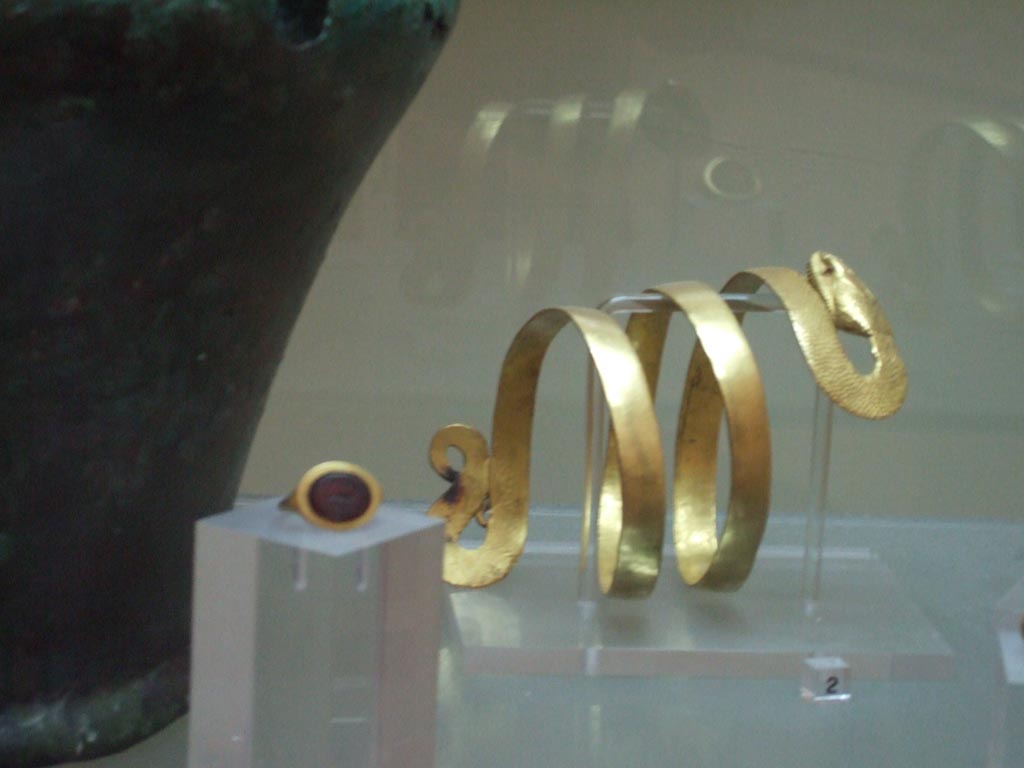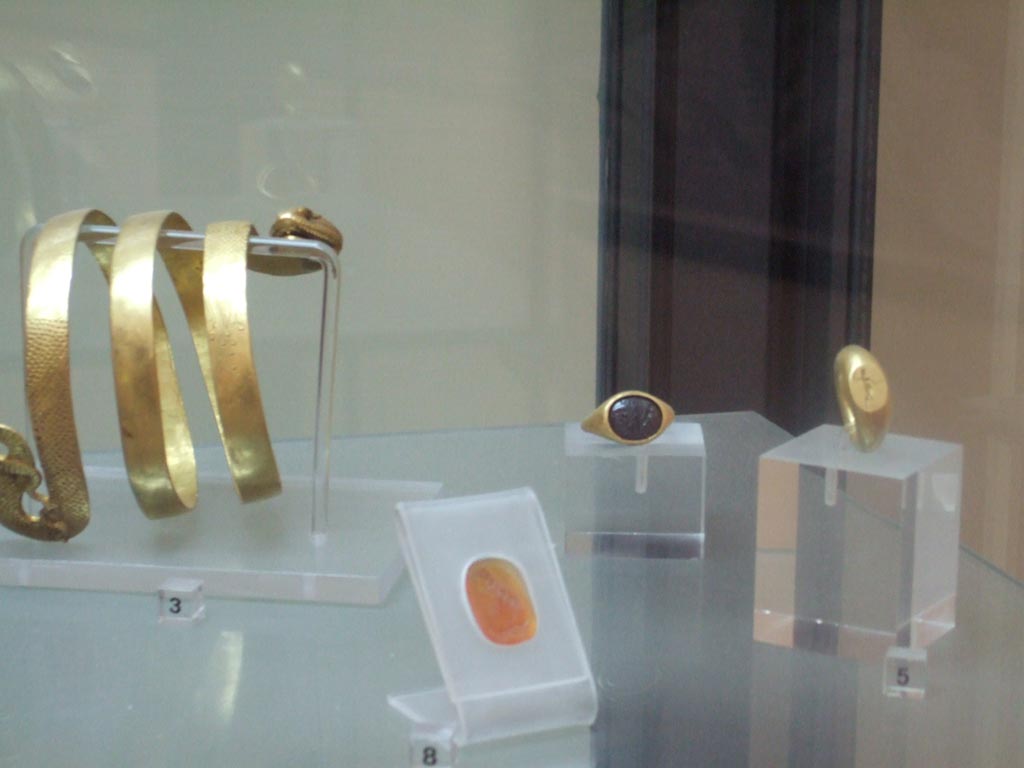VI.12.2 Pompeii. Casa del Fauno or House of the Faun.
Linked to VI.12.1,
VI.12.3, VI.12.5, VI.12.7 and VI.12.8.
Part 12 Part 1 Part 2
Part 3 Part 4 Part 5
Part 6 Part 7
Part 8 Part 9 Part 10 Part 11 Plan

VI.12.2 Pompeii. September 2015.
Corridor, on east side of oecus/triclinium, looking south to middle (first) peristyle.
Foto Annette Haug, ERC Grant 681269
DÉCOR.

VI.12.2 Pompeii. September 2005. Corridor, on east side of oecus/triclinium, looking south to middle peristyle.

VI.12.2 Pompeii. September 2015.
Upper corridor, on east side of oecus/triclinium, looking south to middle peristyle.
Foto
Annette Haug, ERC Grant 681269 DÉCOR.

VI.12.2 Pompeii. September 2015. Detail of flooring in corridor, on east side of oecus/triclinium. Looking south.

VI.12.2 Pompeii. May 2015. Looking south from north end of corridor. Photo courtesy of Buzz Ferebee.

VI.12.2 Pompeii. September 2017.
Looking south along east side of Middle Peristyle, towards doorway to room 51.
Foto
Annette Haug, ERC Grant 681269 DÉCOR.

VI.12.2 Pompeii. March 2014. Looking south along east side of Middle Peristyle.
Foto Annette Haug, ERC Grant 681269
DÉCOR.

VI.12.2 Pompeii. March 2014. South-east corner of Middle Peristyle, doorway to room 51, looking south.
Foto
Annette Haug, ERC Grant 681269 DÉCOR.

VI.12.2 Pompeii. September 2015.
South-east corner of Middle Peristyle, with doorway to corridor 19 in centre, and into room 51 on right, looking east.
Foto
Annette Haug, ERC Grant 681269 DÉCOR.

VI.12.2 Pompeii. September 2015. Doorway to Corridor 19, from south-east corner of Middle Peristyle.
Foto Annette Haug, ERC Grant 681269
DÉCOR.

VI.12.2 Pompeii. January 2017. Looking north along corridor leading to rear peristyle.
Foto
Annette Haug, ERC Grant 681269 DÉCOR.

VI.12.2 Pompeii. September 2015. Looking north along Corridor 19.
Foto
Annette Haug, ERC Grant 681269 DÉCOR.

VI.12.2 Pompeii. September 2021.
Looking towards north wall and north-east corner of kitchen, the first room at the north end of the corridor.
Photo
courtesy of Klaus Heese.
(PPM
– room 24)

VI.12.2 Pompeii. January 2017. Doorway into kitchen, on east side of corridor leading north to rear peristyle.
Foto Annette Haug, ERC Grant 681269 DÉCOR.
(PPM
– room 24)

VI.12.2 Pompeii. March 2014. Looking towards north wall and north-east corner of kitchen, across Corridor 19.
Foto Annette Haug, ERC Grant 681269 DÉCOR.
(PPM
– room 24)

VI.12.2
Pompeii. August 1976. Looking towards north wall of kitchen, with arched
aedicula niche.
Looking
east over wall from first (middle) peristyle, into corridor with doorway to
kitchen.
Photo
courtesy of Rick Bauer, from Dr George Fay’s slides collection.
(PPM
– room 24)

VI.12.2 Pompeii. 1964.
Looking north-east from middle garden across corridor, to north wall of kitchen with its arched niche lararium. Photo by Stanley A. Jashemski.
Source: The Wilhelmina and Stanley A. Jashemski archive in the University of Maryland Library, Special Collections (See collection page) and made available under the Creative Commons Attribution-Non-Commercial License v.4. See Licence and use details.
J64f1083

VI.12.2 Pompeii. December 2018.
Looking towards north wall of kitchen with arched niche lararium, and east wall with window. Photo courtesy of Aude Durand.
(PPM – room 24)

VI.12.2 Pompeii. December 2006. Looking towards north-east corner of kitchen, the first room at the north end of the corridor.
North wall of kitchen with arched aedicula niche, on east side of first peristyle.
(PPM – room 24)

VI.12.2 Pompeii. September 2021.
Looking towards north wall of Kitchen, arched niche lararium with aedicula façade.
Photo courtesy of Klaus Heese
(PPM – room 24)

VI.12.2 Pompeii. December 2006. North wall of Kitchen, arched niche lararium with aedicula façade.
According to Boyce, there was a heavy and well-made aedicula façade with two red pilasters supporting a simple pediment.
Inside the niche and around the curve was a modelled stucco cornice.
Within the niche there stood a small terracotta altar.
See Boyce G. K., 1937. Corpus of the Lararia of Pompeii. Rome: MAAR 14. (p.52, 190, Pl. 5, 2).
(PPM – room 24)

VI.12.2 Pompeii. December 2006. North wall of kitchen, with detail of stucco decoration on the arched niche.
(PPM – room 24)

VI.12.2 Pompeii. pre-1937-39. North wall of Kitchen, arched niche lararium with aedicula façade.
Photo courtesy of American Academy in Rome, Photographic Archive. Warsher collection no. 1551
(PPM – room 24)

VI.12.2 Pompeii. December 2006. Niche on west wall of kitchen, with doorway to Corridor 19, on left.
(PPM – room 24)

VI.12.2 Pompeii. December 2006. Looking north along corridor 19 towards rear peristyle, and stairs to upper floor.

VI.12.2 Pompeii. December 2006. Corridor 19 on east side, looking south to atrium of VI.12.5.

VI.12.2 Pompeii. March 2014. Corridor 19, looking north.
Foto
Annette Haug, ERC Grant 681269 DÉCOR.

VI.12.2 Pompeii. January 2017. Doorway into room on south side of kitchen, on east side of corridor.
Foto Annette Haug, ERC Grant
681269 DÉCOR.
(PPM – room
22, leading into room 23)

VI.12.2 Pompeii. September 2015.
Second room at north end of corridor, part of bath suite with remains of hypocaust.
Foto Annette Haug, ERC Grant 681269 DÉCOR.
(PPM – room
22/23)

VI.12.2 Pompeii. September 2015.
Second room at north end of corridor, part of bath suite with remains of hypocaust.
Foto Annette Haug, ERC Grant 681269 DÉCOR.
(PPM – room
22/23)

VI.12.2 Pompeii. December 2006.
Second room at north end of corridor on east side, part of bath suite with remains of hypocaust.
(PPM – room
22/23)

VI.12.2 Pompeii. September 2015. Looking east through doorway into latrine.
Foto Annette Haug, ERC Grant
681269 DÉCOR.
(PPM – room
21)

VI.12.2 Pompeii. September 2015.
Looking east into latrine, third room on east side from north end in Corridor 19.
Foto
Annette Haug, ERC Grant 681269 DÉCOR.
(PPM
– room 21)

VI.12.2 Pompeii. March 2014.
Looking east into latrine, third room on east side from north end in Corridor 19.
Foto
Annette Haug, ERC Grant 681269 DÉCOR.
(PPM – room
21)

VI.12.2 Pompeii. December 2006. Latrine, third room from north end of corridor, room on east side.
(PPM – room
21)

VI.12.2 Pompeii. September 2015.
Looking east through doorway into fourth room from north end of Corridor 19.
Foto Annette Haug, ERC Grant 681269 DÉCOR.
(PPM – room 20)

VI.12.2 Pompeii. December 2006. Fourth room from north end of corridor, room on east side.
(PPM – room
20)

VI.12.2 Pompeii. September 2021.
Room 17 at south end of corridor on east side. On the right is a doorway into the north side of the atrium of VI.12.5.
Photo
courtesy of Klaus Heese.

VI.12.2 Pompeii. December 2006.
Room 17 at south end of corridor on east side. On the right is a doorway into the north side of the atrium of VI.12.5.

VI.12.2 Pompeii. September 2021.
Room 17 at south end of corridor on east side, looking
towards south-east corner with steps. Photo courtesy of Klaus Heese.

VI.12.2 Pompeii. December 2006. Looking east in room 17, another set of steps in north-east corner.

VI.12.2 Pompeii. W.1132.
Looking north towards doorway to corridor, in room at south end of corridor on east side.
On the left in the corridor is a doorway leading to the south-east corner of the first or middle peristyle.
Photo by Tatiana
Warscher. Photo © Deutsches Archäologisches Institut, Abteilung Rom, Arkiv.

VI.12.2 Pompeii. Silver found in VI.12.2. Now in Naples Archaeological Museum.
Urceolus or small jug or pitcher (left front) with female head. Inventory number 25680.
Patera or drinking vessel (right front) with indented pattern on the sides of the bowl and naked figure of Mercury on handle. Inventory number 25338.
Patera (Left rear) with the handle decorated with the head of a faun. Inventory number 25340.
Patera (Right rear) with less ornate handle. Inventory number 25339.
See Guzzo, P. (A cura di), 2006. Argenti a Pompei. Milano, Electa. (p. 112-113, Nos. 102-5).

VI.12.2 Pompeii. September 2024.
Display case with items – Portable bronze brazier, stove and bronze chafing dish.
On the right is the marble table support in the form of a sphinx, found between the columns in the second peristyle on 1st July 1831.
Now in Naples Archaeological Museum. Photo courtesy of Giuseppe Ciaramella.

VI.12.2 Pompeii. September 2024.
Display case with items – Portable bronze brazier, stove and bronze chafing dish.
Now in Naples
Archaeological Museum. Photo courtesy of Giuseppe Ciaramella.

VI.12.2 Pompeii. September 2024.
Information card from Naples Archaeological Museum. Photo courtesy of Giuseppe Ciaramella.

VI.12.2 or VII.9.20 Pompeii. Bronze brazier found in VI.12.2, according to card in Naples Museum.
Now in Naples Archaeological Museum. Inventory number 72991.
According to Pagano and Prisciandaro, this was found in VII.9.20, a shop, on 25th May 1822.
See Pagano, M.
and Prisciandaro, R., 2006. Studio sulle
provenienze degli oggetti rinvenuti negli scavi borbonici del regno di
Napoli. Naples: Nicola Longobardi, (p. 124).
See Fiorelli G., 1862. Pompeianarum
antiquitatum historia, Vol. 2: 1819 - 1860, Naples, p. 52-53.

VI.12.2 Pompeii. Found on 5th November 1830. Bronze food or water warmer.
Now in Naples Archaeological Museum. Inventory number 78673.
See
Fiorelli G., 1862. Pompeianarum antiquitatum historia,
Vol. 2: 1819 - 1860,
Naples, p. 242-243.

VI.12.2 Pompeii. Found on 5th November 1830. One handled bronze jug.
Now in Naples Archaeological Museum. Inventory number 69429.
See
Fiorelli G., 1862. Pompeianarum antiquitatum historia,
Vol. 2: 1819 - 1860,
Naples, p. 242-243.

VI.12.2 Pompeii. Found on 5th November 1830. One handled bronze jug.
Now in Naples Archaeological Museum. Inventory number 69428.
See
Fiorelli G., 1862. Pompeianarum antiquitatum historia,
Vol. 2: 1819 - 1860,
Naples, p. 242-243.

VI.12.2 Pompeii. One handled bronze jug, with small limestone altar, below.
Now in Naples Archaeological Museum. Inventory number 69425.
The small altar (second half of the 2nd century BC), found 1831, now in Naples Archaeological Museum. Inv. 2550 (Vetter 21), with Oscan inscription, written from right to left, reading –
“To flora”
(Piccola ara
(seconda metà del II secolo a.C.), trovato 1831, inv. 2550 (Vetter 21), alfabeto
osco, scrittura da destra verso sinistra –
“A Flora”)
According to the information card in Naples Museum –
“Flora is one of the minor deities connected to the regenerative cycles of nature. Her cult was diffused through the Italic world, and is attested in Rome as well”.
(“Flora è una
delle divinità minori legate ai cicli rigenerativi della natura, il cui culto
era diffuso nel mondo italico e si ritrova anche a Roma.”)

VI.12.2 Pompeii. Found on 5th November 1830. One handled bronze jug.
Now in Naples Archaeological Museum. Inventory number 69427.
See
Fiorelli G., 1862. Pompeianarum antiquitatum historia,
Vol. 2: 1819 - 1860,
Naples, p. 242-243.

VI.12.2 Pompeii. Jewellery found in VI.12.2. Now in Naples Archaeological Museum.

VI.12.2 Pompeii. Found 4th March 1831. Gold bracelet with body of a serpent.
Now in Naples Archaeological Museum. Inventory number 24824.
Gold ring with a virile nude figure and the inscription CAS-SIA.
Now in Naples Archaeological Museum. Inventory number 25136.

VI.12.2 Pompeii. Found 4th March 1831. Gold bracelet with body of a serpent (at back). Inventory number 24825.
Gold ring (on left). Inventory number 25107.
Carving on cornelian of bust of a youth, possible Alexander the Great (on right). Inventory number 26766.
Now in Naples Archaeological Museum.

VI.12.2 Pompeii. Found 4th March 1831. Jewellery found in VI.12.2.
Carving on cornelian of bust of a youth, possible Alexander the Great (in front). Inventory number 26766.
Gold ring with oval centre representing Hercules in the garden of Hesperides (on right). Inventory number 25132.
Gold ring with nude figure, with discus/shield and javelin (at rear). Inventory number 25084.
Now in Naples Archaeological Museum.

VI.12.2
Pompeii. Travertine dedication, written from right to left in Oscan alphabet.
It reads –
“Spurius
(son of) Ma(raius), quaestor, by decree of the assembly, had (this) made.”
Now in
Naples Archaeological Museum, inv. 2544. Photo courtesy of Giuseppe Ciaramella,
June 2017.
Part 1 Part 2
Part 3 Part 4 Part 5
Part 6 Part 7 Part 8
Part 9 Part 10 Part 11
Plan